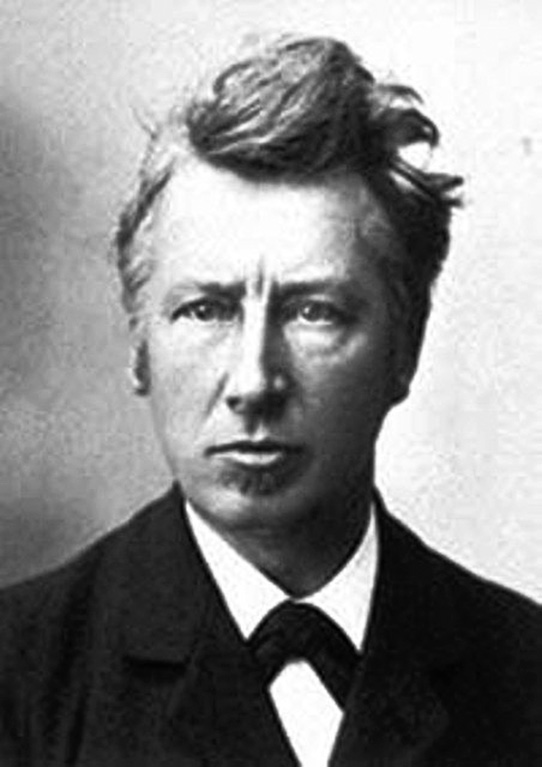Jacobus Henricus van ‘t Hoff (1852–1911)
The Father of Physical Chemistry
The prestigious Nobel Prizes were first awarded in 1901 and the first Nobel Laureate in Chemistry was the well-known Dutch physical chemist with a wealth of pioneering research work to his name – Jacobus Henricus van ‘t Hoff. He won the award “in recognition of the extraordinary services” he had rendered “by the discovery of the laws of chemical dynamics and osmotic pressure in solutions”. His meticulous research work had shown that very dilute solutions follow laws that are similar to those related to the behaviour of gases.
What’s also noteworthy about van ‘t Hoff is that even before he completed his doctoral dissertation, at the young age of 22, he published at his own cost an 11-page pamphlet titled The Arrangement of the Atoms in Space in which he made an innovative suggestion. He proposed a three-dimensional structure of an asymmetrical tetrahedral carbon atom – the carbon atom being at the centre of a regular tetrahedron with each of its four bonds/valence electrons pointed towards its corners. His stereochemical model of simple carbon compounds, he claimed, would explain the baffling cases of optical isomerism shown by some chemical compounds. However, till he published a German translation of the earlier Dutch pamphlet three years later, his theory was for the most part ignored by the scientific community. A leading chemist, Hermann Kolbe actually wrote: “A Dr. J. H. van ‘t Hoff of the Veterinary School at Utrecht has no liking, apparently, for exact chemical investigation.” The Veterinary School was where van ‘t Hoff first started teaching.
Ironically, van ‘t Hoff’s theory went on to not only emerge as one of the principle concepts of organic chemistry, it also paved the way for the introduction of the new science of stereochemistry.
Early life
Jacobus Henricus van ‘t Hoff was born in Rotterdam on August 30, 1852. His father, a physician, wasn’t too happy about his interest in becoming a chemist, thinking his son would be better off following in his own footsteps and becoming a medical doctor.
But, going against his father’s wishes, van ‘t Hoff studied chemistry at the Delft Polytechnic Institute, completing the three-year course in two years, at the age of 19. He then studied mathematics for a year at the University of Leiden, and at 22, completed his doctorate from Utrecht University, before starting work in 1876 as an academic in Utrecht, and later on teaching at the University of Amsterdam and Berlin University.
Besides science, van ‘t Hoff had a deep interest in philosophy and poetry, and was a lover of nature. Passionate about writing till the very end, he had even attempted writing poetry as a young man, his idol being Lord Byron.
Van ‘t Hoff staunchly believed that the power of imagination plays a key role in the engagement of scientific work and making new discoveries. In his inaugural address after being appointed Professor of Chemistry, Mineralogy, and Geology at the University of Amsterdam in 1877 he said that his meticulous study of the lives of several outstanding scientists had revealed to him that all of them had a high level of imagination.
Contributions to science
Jacobus Henricus van ‘t Hoff’s postulation of the three-dimensional structure of molecules, led to the discovery of the three-dimensional structure of proteins and half a century later to the decoding of the double helix structure of the DNA molecule.
Though he started out as an organic chemist, later on, van ‘t Hoff’s work was mainly in the areas of theoretical and physical chemistry. His exhaustive study of the thermodynamic properties of dilute solutions and application of the laws of thermodynamics to chemical equilibria led him to propose the concept of chemical affinity. Having successfully used the principles of physics to calculate the speed of chemical reactions, he showed that solutions obey many of the same laws as gases. His innovative research earned him not just the first Nobel Prize for chemistry, but also acknowledgement as one of the founders of physical chemistry. One of the rules of chemical thermodynamics that relates temperature changes to changes in equilibrium constant – the Van ‘t Hoff equation – has been named after him.
Elected a member of a number of reputed societies and academies in the world, including the Royal Netherlands Academy of Sciences, van ‘t Hoff soon became famous as one of the outstanding researchers of his time. He was also awarded honorary doctorates by world renowned universities such as Harvard, Yale, Victoria University, Manchester University, and University of Heidelberg. His extensive body of research work was published in the form of scientific papers and books too.
Premature death at a productive age
Unfortunately, Jacobus Henricus van ‘t Hoff died on March 1, 1911, at the age of 58 after succumbing to pulmonary tuberculosis at Stiglitz, near Berlin. It was a sad day when death snatched away a great scientist while he was still actively involved in his research and writing work. Soon after his death, in a moving tribute to him, one of his former students, Professor Harry C. Jones of Johns Hopkins University, USA, wrote in the Popular Science Monthly: “The death of Van ‘t Hoff removes one of the leading men of science not only of this age, but of all time.”
References
- Nobel Media AB 2014: Jacobus H. van ‘t Hoff – Facts – www. nobelprize.org/nobel_prizes/
- Harry C. Jones: Jacobus Henricus van’t Hoff – American Philosophical Society, Vol. 50, No. 202, Oct. – Dec., 1911
- New World Encyclopaedia: Jacobus Henricus van ‘t Hoff, www.newworldencyclopedia.org
4. G. Nagendrappa: Jacobus Henricus van ‘t Hoff, A short biographical sketch – Resonance, Journal of Science Education, Indian Academy of Sciences, May 2007.

































